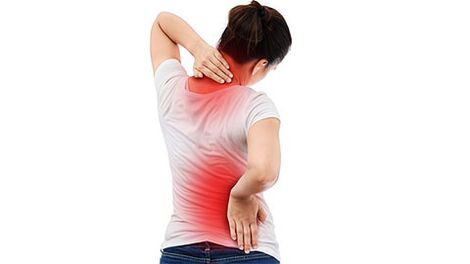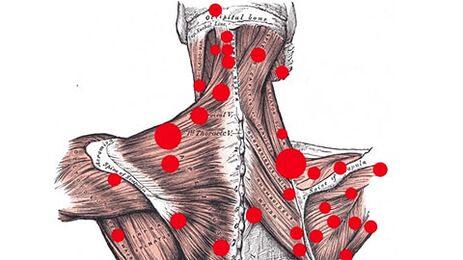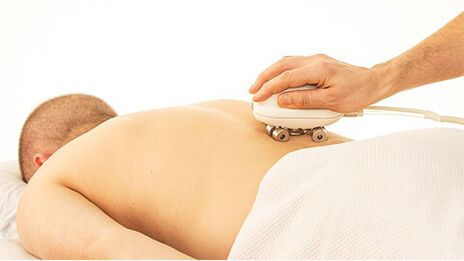
Back pain is a common problem among middle-aged and elderly patients. It can be caused by an incorrect lifestyle, pathologies of the musculoskeletal system, diseases of internal organs. A neurologist, orthopedist, nephrologist and urologist can treat back pain, depending on its origin. It is difficult for the patient to understand for himself the cause of the unpleasant sensations and to choose the right doctor. Therefore, it is first necessary to contact a therapist, who, depending on the symptoms, history and results of the studies performed, will refer you to a close specialist.
Distribution
Back pain can be:
- Myofasiale.
- Nociceptive.
- Neuropathic.
- Psychogenic.
Myofascial painobserved during the formation of the so-called. trigger points in the back muscles. Trigger points are pea-like joints that form when muscles are constantly tense (when they simply cannot relax). Moreover, when one segment of the muscle fibers is compressed, the others stretch. This affects the movement of muscle fibers: it is limited. The fiber itself shortens, becomes narrower.
Trigger points arise from muscle overload. Moreover, overload can occur not only due to excessive physical activity, but also due to prolonged stay in one position (for example, sitting at a computer). Also, trigger points often occur with osteochondrosis.
Another factor that contributes to the formation of trigger points is the excessive stimulation of sarcomeres (basic constriction units that are a complex of proteins). If there is excessive stimulation of the sarcomeres, they are constantly in a contracted state.

The presence of trigger points does not allow the muscles to fully relax. She starts to get tired quickly even with small loads, overestimates when she moves and heals very slowly. The limited range of its movement affects the entire fascial chain. Other muscles and even some joints also become less mobile.
Blood flow to the tissues surrounding the causative point also suffers. Because of this, oxygen starvation is observed in this area. The products of decay accumulate, irritate the trigger point and pain develops due to this. In this case, the size of the muscle does not matter, it all depends on the degree of irritation of the point. Even the smallest muscles in the presence of trigger points in it can give a lot of uncomfortable sensations.
A characteristic feature of myofascial pain is their reflection. This means that the pain is reflected in other parts of the body. They can occur in areas very far from the trigger points. Thus, for example, pain under the shoulder blades or in the lower back may develop due to the presence of joints in the abdominal muscles. Also, the lower back can be damaged due to trigger points in the calf region or buttocks.
Myofascial pain is usually long-lasting and dull. Sometimes they occur only when moving, sometimes at rest. They can vary in strength: from minor discomfort to excruciating pain.
Nociceptive pain- the body's response to direct irritation of pain receptors (nociceptors). In the case of the spine, these are receptors located in the paravertebral ligaments, muscles, tendons, as well as in the articular capsules of the intervertebral joints and the outer third of the fibrous ring of the intervertebral disc. The patient may experience pain with reflex muscle spasm, dystrophic or pathological processes in the facial joints. When moving, the pain intensifies.
Neuropathic paindevelop in pathological processes in the nervous system: damage to the nerves or roots of the peripheral nervous system, disruption of the central nervous system. Such pain can be observed with osteoporosis, spondylolisthesis, hernias and spinal fractures. They intensify when they bend, move, strain, cough, sneeze and in most cases are given to the limb. Sometimes they are dull and painful, but more often they are sharp, shooting.
Psychogenic painoccur due to muscle spasm caused by emotional stress, chronic stress, or anxiety disorder.
In some cases, the varieties can be combined with each other. For example, myofascial sensations coexist with nociceptive ones.
Also, back pain is divided into 3 types:
- Acute (lasts less than 6 weeks).
- Subacute (6-12 weeks).
- Chronic (more than 3 months).
Acute / subacute painusually develops due to tissue damage (deep, superficial) due to cuts, wounds, inflammations. Thus, the body warns us that something is wrong. The pain goes away after the tissues are completely healed.
Chronic painoccurs due to diseases of organs and systems or emotional disorders. If present, a thorough medical examination is required.
Depending on the location, the pain may be:
- Local.
- Reflected.
- Radiators.
Local pain develops directly at the site of development of the pathological process. Reflected - if there are trigger points. Radiation - with damage to internal organs, spreads along nerve fibers.
Why does my back hurt?
Back pain can be caused by a number of reasons, which include:
- Bending of the spine: scoliosis, kyphosis.
- Neurological diseases: herniated intervertebral discs, osteochondrosis, spondylosis, spondyloarthritis.
- Endocrine pathologies: osteoporosis.
- Diseases of the respiratory system: pleurisy.
- Kidney and urinary system pathologies: urolithiasis, pyelonephritis, glomerulonephritis.
- Tumors.
Short-term pain (usually severe, burning) can be due to a variety of reasons. This includes:
- Injuries.
- Muscle overload (due to a monotonous posture or performing the same type of repetitive movements).
- Hypothermia.
Pain caused by degenerative processes occurs with the following diseases:
- Osteochondrosis.
- Intervertebral hernia.
- Exit of the intervertebral disc.
- Deforming spondylosis.
- Degenerative scoliosis.
- Osteoarthritis.
- Spondylolistema (displacement of the vertebrae).
- Spondylolysis (non-union of the vertebral arch).
- Spinal stenosis.
Radiation pain in the back can develop due to diseases:
- Heart and large vessels: myocardial infarction, angina pectoris, aortic aneurysm.
- Lungs: cancerous tumors, pleurisy.
- Esophagus.
- Gallbladder and bile duct: acute and chronic cholecystitis.
- Kidney and urinary tract.
- Pancreas.
Back pain in rare cases can be of infectious origin. For example, sometimes my back hurts with the flu. Also, the infection can penetrate into the spine from nearby organs: urinary tract, kidneys.
Other reasons for the development of back pain may be changes in hormonal levels (for example, age-related, during or after menopause). In this case, hormonal spondylopathy occurs (degenerative changes in the spine)
The back hurts a lot: what to do?
If you have a severe pain attack, be sure to see a doctor as soon as possible. However, if the sensations are so strong that any movement causes discomfort, first aid is needed. You should lie on your back on a flat, firm surface (for example, on the floor). This will help relieve spasms, relax muscles and reduce pain.
By sinking on a flat surface, do not change the position of the back. Lying on your back, try to roll sideways. This will ease the spine. When the pain subsides, roll back on your back. It is recommended to place something under your feet, raising them up. Lie in this position for 10-15 minutes.
You also need to climb correctly: first turn sideways. From this position, climb on all fours. Then lean on something (if there is no support nearby - crawl on it) and slowly get up. Only then carefully turn your back.
To find out why your back hurts badly, do not postpone a visit to the doctor. This will help avoid new attacks.
Diagnosing
You should definitely make an appointment with a therapist if you have back pain:
- appear during physical exertion, muscle tension;
- last more than 3 days;
- repeated episodically.
It is necessary to visit a doctor immediately in the following cases:
- back hurts constantly;
- an increase in body temperature, numbness of the limbs, lethargy of the limbs in the morning add to the pain;
- in the supine position, the pain does not pass;
- worse pains at night.
At the meeting, the doctor will collect a medical history, examine the patient (assess the condition of the skin, body position and symmetry, gait, etc. ). He will then assign studies:
- general analysis of blood and urine;
- x-rays;
- computed tomography;
- magnetic resonance.
If necessary, the therapist will refer the patient to a neurologist, orthopedist, urologist, gynecologist or nephrologist.
Treatment of back pain

Treatment for back pain is comprehensive and may include:
- taking medications (anti-inflammatory, pain relievers, healing medications);
- blockade (long-term pain relief);
- physiotherapy procedures;
- physiotherapy exercises;
- massages;
- manual therapy.
If conservative methods do not give the desired result, surgical treatment is prescribed. Modern methods make it possible to perform precision low trauma surgeries with a short rehabilitation period.
Prevention of back pain
Simple preventative measures can help prevent back pain. Necessary:
- Monitor your behavior.
- Sleep in a bed with a firm mattress.
- By engaging in activities that involve a long sitting position (driving, computer work), it is necessary to change behaviors from time to time, as well as organize vacations and warm-ups.
- When staying for a long time, rely on something.
- Do not wear high heels for more than 2 hours in a row.
- Spend time with moderate physical activity (swimming, fitness).
- Observe your weight - back pain can occur due to the presence of excess pounds.
- Try not to lift weights.
- Do not bend or bend with sudden movements.
- Treat urological and gynecological diseases in time.
Annual preventive visits to the therapist will also be helpful. Pathologies identified in the early stages can be eliminated without waiting for the development of complications.






















